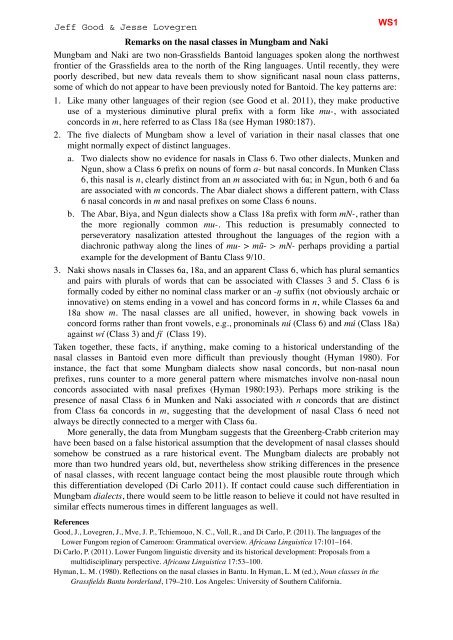here - 5th International Conference on Bantu Languages
here - 5th International Conference on Bantu Languages
here - 5th International Conference on Bantu Languages
Create successful ePaper yourself
Turn your PDF publications into a flip-book with our unique Google optimized e-Paper software.
Remarks <strong>on</strong> the nasal classes in Mungbam and Naki<br />
Mungbam and Naki are two n<strong>on</strong>-Grassfields Bantoid languages spoken al<strong>on</strong>g the northwest<br />
fr<strong>on</strong>tier of the Grassfields area to the north of the Ring languages. Until recently, they were<br />
poorly described, but new data reveals them to show significant nasal noun class patterns,<br />
some of which do not appear to have been previously noted for Bantoid. The key patterns are:<br />
1. Like many other languages of their regi<strong>on</strong> (see Good et al. 2011), they make productive<br />
use of a mysterious diminutive plural prefix with a form like mu-, with associated<br />
c<strong>on</strong>cords in m, <str<strong>on</strong>g>here</str<strong>on</strong>g> referred to as Class 18a (see Hyman 1980:187).<br />
2. The five dialects of Mungbam show a level of variati<strong>on</strong> in their nasal classes that <strong>on</strong>e<br />
might normally expect of distinct languages.<br />
a. Two dialects show no evidence for nasals in Class 6. Two other dialects, Munken and<br />
Ngun, show a Class 6 prefix <strong>on</strong> nouns of form a- but nasal c<strong>on</strong>cords. In Munken Class<br />
6, this nasal is n, clearly distinct from an m associated with 6a; in Ngun, both 6 and 6a<br />
are associated with m c<strong>on</strong>cords. The Abar dialect shows a different pattern, with Class<br />
6 nasal c<strong>on</strong>cords in m and nasal prefixes <strong>on</strong> some Class 6 nouns.<br />
b. The Abar, Biya, and Ngun dialects show a Class 18a prefix with form mN-, rather than<br />
the more regi<strong>on</strong>ally comm<strong>on</strong> mu-. This reducti<strong>on</strong> is presumably c<strong>on</strong>nected to<br />
perseveratory nasalizati<strong>on</strong> attested throughout the languages of the regi<strong>on</strong> with a<br />
diachr<strong>on</strong>ic pathway al<strong>on</strong>g the lines of mu- > mũ- > mN- perhaps providing a partial<br />
example for the development of <strong>Bantu</strong> Class 9/10.<br />
3. Naki shows nasals in Classes 6a, 18a, and an apparent Class 6, which has plural semantics<br />
and pairs with plurals of words that can be associated with Classes 3 and 5. Class 6 is<br />
formally coded by either no nominal class marker or an -ŋ suffix (not obviously archaic or<br />
innovative) <strong>on</strong> stems ending in a vowel and has c<strong>on</strong>cord forms in n, while Classes 6a and<br />
18a show m. The nasal classes are all unified, however, in showing back vowels in<br />
c<strong>on</strong>cord forms rather than fr<strong>on</strong>t vowels, e.g., pr<strong>on</strong>ominals nú (Class 6) and mú (Class 18a)<br />
against wí (Class 3) and fí (Class 19).<br />
Taken together, these facts, if anything, make coming to a historical understanding of the<br />
nasal classes in Bantoid even more difficult than previously thought (Hyman 1980). For<br />
instance, the fact that some Mungbam dialects show nasal c<strong>on</strong>cords, but n<strong>on</strong>-nasal noun<br />
prefixes, runs counter to a more general pattern w<str<strong>on</strong>g>here</str<strong>on</strong>g> mismatches involve n<strong>on</strong>-nasal noun<br />
c<strong>on</strong>cords associated with nasal prefixes (Hyman 1980:193). Perhaps more striking is the<br />
presence of nasal Class 6 in Munken and Naki associated with n c<strong>on</strong>cords that are distinct<br />
from Class 6a c<strong>on</strong>cords in m, suggesting that the development of nasal Class 6 need not<br />
always be directly c<strong>on</strong>nected to a merger with Class 6a.<br />
More generally, the data from Mungbam suggests that the Greenberg-Crabb criteri<strong>on</strong> may<br />
have been based <strong>on</strong> a false historical assumpti<strong>on</strong> that the development of nasal classes should<br />
somehow be c<strong>on</strong>strued as a rare historical event. The Mungbam dialects are probably not<br />
more than two hundred years old, but, nevertheless show striking differences in the presence<br />
of nasal classes, with recent language c<strong>on</strong>tact being the most plausible route through which<br />
this differentiati<strong>on</strong> developed (Di Carlo 2011). If c<strong>on</strong>tact could cause such differentiati<strong>on</strong> in<br />
Mungbam dialects, t<str<strong>on</strong>g>here</str<strong>on</strong>g> would seem to be little reas<strong>on</strong> to believe it could not have resulted in<br />
similar effects numerous times in different languages as well.<br />
References<br />
Good, J., Lovegren, J., Mve, J. P., Tchiemouo, N. C., Voll, R., and Di Carlo, P. (2011). The languages of the<br />
Lower Fungom regi<strong>on</strong> of Camero<strong>on</strong>: Grammatical overview. Africana Linguistica 17:101–164.<br />
Di Carlo, P. (2011). Lower Fungom linguistic diversity and its historical development: Proposals from a<br />
multidisciplinary perspective. Africana Linguistica 17:53–100.<br />
Hyman, L. M. (1980). Reflecti<strong>on</strong>s <strong>on</strong> the nasal classes in <strong>Bantu</strong>. In Hyman, L. M (ed.), Noun classes in the<br />
Grassfields <strong>Bantu</strong> borderland, 179–210. Los Angeles: University of Southern California.<br />
WS1


